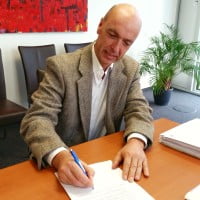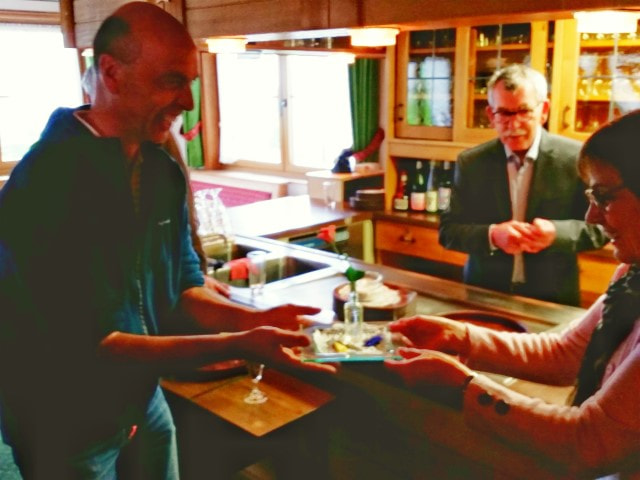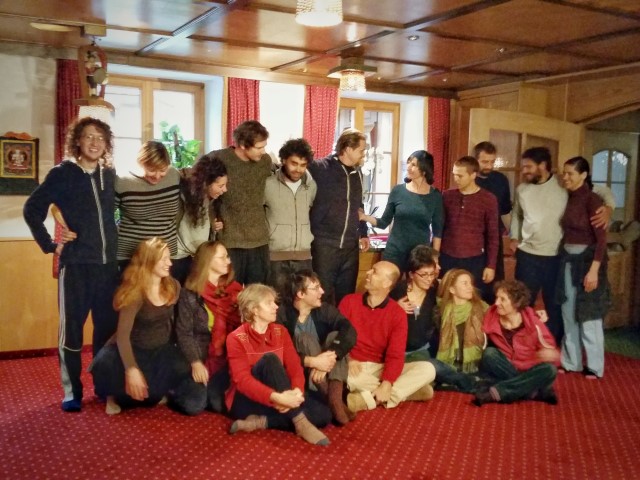Why such a retreat place?
Motivated practitioners wishing to practice meditation intensively with good retreat guides were looking for a place to do several years of retreat. As vacation rentals available for long-term booking were rare around Lama Tilmann’s original place in the black forest, we began searching for a suitable place in early 2014 and finally found the hotel “Grüner Baum” in Raitenbuch, at 970 m altitude in the heart of the Upper Black Forest. October 30th, 2015, we made our first visit. An appealing site with large rooms and beautiful surroundings. Some of us “fell in love” with the place, just like the regular customers of the hotel. This is where you now find the opportunity for a long retreat without having to formally adhere to one tradition. Ekayana is open to all Buddhist traditions, and qualified teachers offer support to anyone truly wishing to train his or her mind in meditation. The demand for such an open approach is high. Many people want to be supported in their spiritual autonomy in order to discover the Buddhist spiritual teaching in a broad way, going beyond a specific tradition. The great positive feedback and substantial donations from hundreds of people show how strongly this wish is present in our times.
What is offered
To answer to this demand, the retreathouse offers a combination of depth and lightness, individual responsibility and devotion, personal practice and group life, Dharma understanding imbued with therapeutic knowledge. If you wish to explore the depths of your own mind and free it from its veils in a longer retreat, ranging from one month to several years, our center will meet this demand.
The rhythm of the retreats is always three months of retreat followed by one month pause; so there are 3 such retreats per year, 9 months in all. Those who wish can continue practicing in retreat during the retreat pauses, when the others join the public teachings or visit their friends and relatives. During the retreats we offer once or twice per week a group teaching. Individual guidance is offered all around: one simply puts one’s name on the whiteboard and the teacher arranges for a personal interview in the days after.
Inner and outer autonomy
We can see that these retreats produce capable practitioners, who are able to provide support to the next generation in the same process. We are lucky to have some young people with us on this project; they enjoy a “retreat without fences”. We encourage spiritual autonomy, not feeding subtle spiritual or emotional dependencies.
This means that every practitioner has to practice self reliance with up to 12 hours of individual meditation per day plus 1 hour of group meditation at 5 p.m. Someone wishing to do retreat here needs to be prepared by a continuous personal practice at home with 2 hours daily and some experience with shorter retreats at home or in groups. The minimum stay at Ekayana is one month. Without such a preparation, it will be too difficult to take care of one’s own practice day after day, all around the clock — without access to distractions. Cell phone and internet remain turned off. There are 4 three-hour sessions of individual practice per day. In the hours of practice are included walks and meditations in nature, yoga etc., and personal study. Exchanges with others take place in the breaks or on walks — silence can be enjoyed all the time except at lunch, when the community meets. Silent days up to one week are possible.
The place itself is autonomous in the sense that it is free of an institutional adherence and it generates its own income through donations. Yet, we are not creating our own Ekayana school, but continuously remain open to all authentic lineages while being firmly rooted in the Tibetan Kagyu tradition (and to some extend in the Nyingma tradition), where we received our own training. The place is open to different styles of practice, with a lot of exchanges among practitioners.
The project has gone and will go through challenges and is, in response to them, continuously adapted in the form of an ongoing fine tuning.
Historical review
The project started at the end of 2014. Sebastian, who had the wish for a long-term retreat, started to look for a possible apartment in the area around Hofsgrund, where Tilmann (Lhundrup) lived at that time. The idea at that time was to build a community of practitioners who would live in individual apartments in the surrounding area and would be supervised by Tilmann. We first found a villa with 7 rooms directly in Hofsgrund. The joint visit made us reflect on the possibility of a common retreathouse for the first time. The house was not suitable, but Tilmann almost playfully encouraged Sebastian to keep quietly looking for similar places
In the fall of 2015, the vision caught fire again when, after a two-month retreat, Sebastian decided to prepare for a long-term retreat, even though there was no suitable place for it yet. The search for houses in the vicinity of Hofsgrund led to a hotel in Todtnauberg at the beginning of October, which was significantly larger than all the houses visited so far. Thus, the vision of a closed long-term retreat house changed into a combined short- and long-term retreat place with the possibility to hold public courses as well. The hotel did not fit. But we could not find any better property in the desired proximity, so we expanded the search radius beyond the Feldberg. At the end of October, Sebastian came across the “Gasthof Grüner Baum” (Green Tree) in Lenzkirch-Raitenbuch. Exposé and floor plans suggested that the house was highly interesting. On Friday, October 30, 2015, during the first walk-through, it became clear that of all the houses visited, it was by far the most attractive.

From that point on things developed quickly: Johann, who after 7 years of retreat did a half year closed retreat in Hofsgrund for reorientation, felt a strong interest with the Green Tree. After a financial expert and an architect gave the green light and the inspection by friends and a large group from a Mahamudra course brought almost only positive feedback, Tilmann started an appeal for donations which made it possible within two weeks (!) to buy the house with donations and private loans from 60 people. In numerous planning meetings Tilmann, Johann and Sebastian worked on the vision and concept of the house. Tilmann founded in no time with the help of Peter, our tax consultant, the non-profit Ekayana gGmbH as the legal sponsor of the project, and on 15th Dec. 2015 the purchase was signed in Freiburg.
Months of intensive concept development followed. Johann soon decided to join the team permanently, and Tilmann, who initially wanted to oversee the project from Hofsgrund, decided to move into the house himself. Dagmar, an architect, began to support the team in planning matters. Contacts with experts in the fields of taxation, structural analysis, heating, insulation, architecture, ecological renovation and much more were established and slowly the ideas began to take shape. Tilmann, Johann and Sebastian worked out the concept of retreats. Tilmann, while recovering from a fractured neck of femur after a Christmas fall from his bike, wrote a first detailed project description. Bettina, who participated in Tilmann’s training in “Essential Psychotherapy” showed interest, as did Ulrich, after seven years in the “Inter-Sein” Meditation Center in Bavaria. Both wanted to move into the house as long-term participants and take on tasks.

The festive handover of the keys from the previous owners, the Meier couple, was on the evening of April 30, and the next day, May 1, we started with a festive Open Day, which was attended by 150 guests. In the morning we welcomed the traditional procession of the Trachtenkapelle Raitenbuch-Falkau and in the afternoon, with strong help from Meiers, there was coffee and cake for all guests with a presentation of the project and the house team. On that day, the project could already count 108 donors.
Then, on May 2, the extensive renovation work began, accompanied during the first 12 days by the transmission and intensive practice of Milarepa Guru Yoga. The following five months we were blessed with numerous helpers who lent a hand in all areas and some of whom stayed for weeks or even months. A team of professionals guided us volunteers in the renovations. In between, there were courses with transmissions that linked the work to the Dharma and made everyone aware of the valuable purpose that the sometimes arduous work served. When opening the walls, it turned out that the renovations would be much more extensive than first thought.
The atmosphere during these months was one of a warm, welcoming community, where we supported each other in solidarity in the tasks and enthusiastically shared our interest in the Dharma. Many helpers kept coming and soon the first two three-month retreats were fully booked. More and more practitioners decided to stay longer at the Green Tree, so that we started the first retreat already with twelve permanent residents.

The first retreat at the Green Tree was marked by the arrival of the group, which had several months of renovation and organizational work behind it. During the first week of transition, the retreatants finished setting up their rooms and the new group of long and short term retreatants got to know each other and had to find their way together. The retreatants gradually settled into the new daily rhythm and the new organization of daily tasks such as cooking, cleaning and washing, which the participants shared in groups of two, had to prove itself and find its way into a routine.
Against this background, these months turned out in surprising harmony, friendship and joy! Practically all participants have experienced the time as extremely nourishing and enriching and the practice could deepen more and more over the weeks.
In the first five years through 2020, we sacrificed summer retreats to have a five-month construction period from mid-April to mid-September. There are many requirements that must be met for such a large, semi-public residential building. To date, the retreats are fully booked, often with waiting lists. We will complete the rest of the renovations in one go. By then we will have offered 18 three-month retreats. In the meantime, we are using this unfinished house and taking it as easy as we can….
